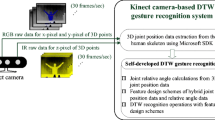Abstract
A subunit-based Dynamic Time Warping (DTW) approach is proposed for hand movement recognition. Two major contributions distinguish the proposed approach from conventional DTW. (1) A set of hand movement subunits is constructed using a data-driven method. The common sub-movements (subunits) are shared across hand gestures to obtain a smaller training data size and search space to improve recognition performance. (2) A similarity measure robust to variability is offered using subunit-to-subunit matching to absorb the difference between two similar sub-sequences belonging to the same subunit, and only keeping the distances between sub-sequences that relate to different subunits. Our experimental results demonstrate the efficiency and accuracy of the proposed approach.
Chapter PDF
Similar content being viewed by others
References
Wachs, J.P., Kolsch, M., Stern, H., Edan, Y.: Vision-based hand-gesture applications. Commun. ACM 54(2), 60–71 (2011)
Okada, S., Hasegawa, O.: Motion recognition based on dynamic-time warping method with self-organizing incremental neural network. In: 19th International Conference on Pattern Recognition, pp. 1–4 (2008)
Roussos, A., Theodorakis, S., Pitsikalis, V., Maragos, P.: Hand tracking and affine shape-appearance handshape subunits in continuous sign language recognition. In: Int. Conf. ECCV Wkshp: SGA (2010)
Bauer, B., Kraiss, K.-F.: Towards an automatic sign language recognition system using subunits. In: Wachsmuth, I., Sowa, T. (eds.) GW 2001. LNCS (LNAI), vol. 2298, pp. 64–75. Springer, Heidelberg (2002)
Elmezain, M., Al-Hamadi, A., Michaelis, B.: Real-time capable system for hand gesture recognition using hidden markov models in stereo color image sequences. Journal of WSCG, 65–72 (2008)
Liddell, S.K., Johnson, R.E.: American sign language: the phonological base. Sign Language Studies 64, 197–277 (1989)
Stokoe, W.: Sign language structure: an outline of the visual communication systems of the American deaf. Studies in Linguistics: Occasional Papers 8 (1960)
Han, J., Awad, G., Sutherland, A.: Modelling and segmenting subunits for sign language recognition based on hand motion analysis. Pattern Recognition Letters, 623–633 (2009)
Niennattrakul, V., Ratanamahatana, C.A.: On clustering multimedia time series data using k-means and dynamic time warping. In: International Conference on Multimedia and Ubiquitous Engineering, pp. 733–738 (2007)
Park, H.S., Jun, C.H.: A simple and fast algorithm for k-medoids clustering. Expert Systems with Applications: An International Journal, 3336–3341 (2009)
Oszust, M., Wysocki, M.: Modelling and Recognition of Signed Expressions Using Subunits Obtained by Data-Driven Approach. In: Ramsay, A., Agre, G. (eds.) AIMSA 2012. LNCS (LNAI), vol. 7557, pp. 315–324. Springer, Heidelberg (2012)
Author information
Authors and Affiliations
Editor information
Editors and Affiliations
Rights and permissions
Copyright information
© 2013 Springer-Verlag Berlin Heidelberg
About this paper
Cite this paper
Wang, Y., Shimada, A., Yamashita, T., Taniguchi, Ri. (2013). A Subunit-Based Dynamic Time Warping Approach for Hand Movement Recognition. In: Petrosino, A. (eds) Image Analysis and Processing – ICIAP 2013. ICIAP 2013. Lecture Notes in Computer Science, vol 8156. Springer, Berlin, Heidelberg. https://doi.org/10.1007/978-3-642-41181-6_68
Download citation
DOI: https://doi.org/10.1007/978-3-642-41181-6_68
Publisher Name: Springer, Berlin, Heidelberg
Print ISBN: 978-3-642-41180-9
Online ISBN: 978-3-642-41181-6
eBook Packages: Computer ScienceComputer Science (R0)





